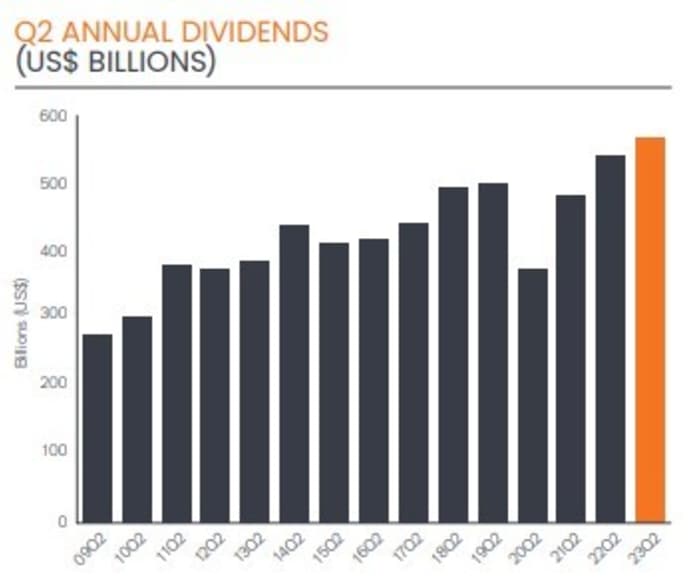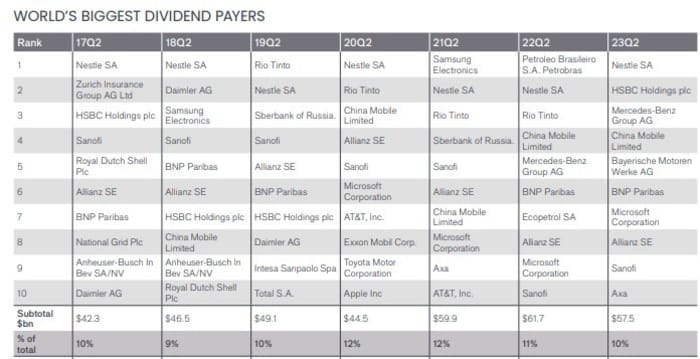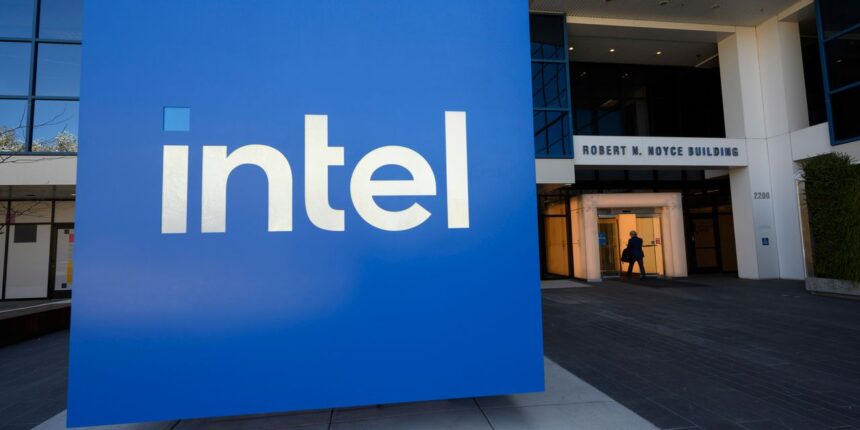Global dividends rose 4.9% to a record $568 billion in the second quarter, but the pace of growth in the U.S. slowed for the sixth consecutive quarter after some high- profile technology and financial groups trimmed their payouts.
In its quarterly survey of the world’s 1,200 biggest public companies by market value, U.K.-based fund manager Janus Henderson said that 88% either increased their dividends or kept them the same over the period.
Even with global economic activity forecast to slow, Janus Henderson maintained its expectations for payouts to hit a full year record of $1.64 trillion in 2023, equivalent to underlying growth of 5%.

Source: Janus Henderson
“Economic growth around the world is moderating as it responds to higher interest rates. Markets now expect global profits to be flat this year, after soaring to record highs in 2022, and when we speak to companies around the world, they are now more cautious about the outlook,” said Ben Lofthouse, head of global equity income at Janus Henderson.
However, he added: “One of the reassuring features of dividend income is that it is typically much less volatile than earnings. Payouts lagged behind profit growth last year and so can therefore exceed it this year.”
The banking sector contributed half of total dividend growth in the second quarter, up 19.7% over the year to a record $85.3 billion, and Lofthouse expected that trend to continue.
“A weaker economic environment is typically negative for banks, but the positive effect on bank margins from the end of years of ultra-low interest rates is very powerful and is driving dividend payouts. The big banks are very tightly regulated and so enter the downturn in a strong capital position,” he said.
However, crimping aggregate dividend growth was the U.S., where the $148 billion payout was up 2.6% on a headline basis as fewer one-off special dividends were distributed.

Source: Janus Henderson
The two biggest dividend cutters were Intel
INTC,
which decided to save nearly $1 billion per quarter, and Blackstone
BX,
which adjusted its payout after lower private asset valuations led to a sharp drop in profits.
Counteracting this was healthcare, which provided the biggest drivers of dividend growth such as UnitedHealth Group
UNH,
and Eli Lilly
LLY,
There was a notable contrast in the UK. too, where the restoration of HSBC’s payout lifted the contribution of the banking sector, but fewer large one-off special dividends and more reductions in regular payouts from miners left the headline total payout down 12.1%.
Strip out the U.K., and European dividend growth was the fastest of any region, up 9.7% to $184.5 billion, led by banks and vehicle manufacturers.
The list of world’s biggest dividend payers continued to be dominated by European based global corporations, with Microsoft
MSFT,
Apple
AAPL,
and Exxon Mobil
XOM,
in seventh, seventeenth and nineteenth position, respectively.

Source: Janus Henderson








